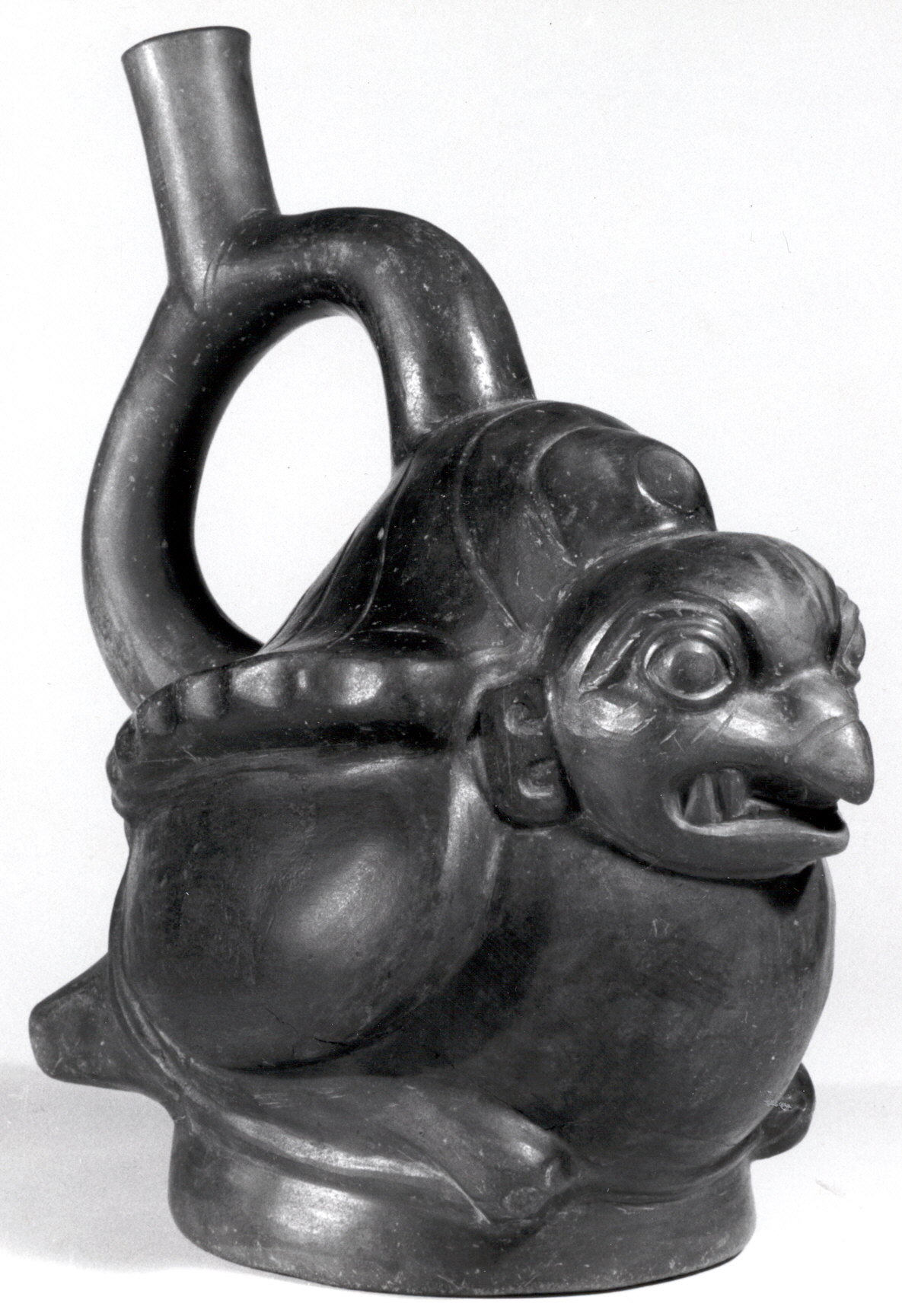Stirrup Spout Bottle with Bird and Snake
Not on view
This black stirrup-spout bottle depicting a bird with a conch shell on its back was fabricated by ceramicists of the Moche culture on the North Coast of Peru. The wide-open eyes, including the small incisions underneath them, are indicative of the avian species, but the E-shaped ears and large incisors suggest a supernatural character. It is unclear if the animal, which based upon the shape of its beak and eyes is a raptor, carries or emanates from the Strombus shell. In its feet the bird clutches a thin snake modeled along the base of the vessel. As there was no tradition of writing in South America prior to the arrival of Europeans in the sixteenth century, it is difficult to determine with precision the meaning of this imagery.
The stirrup-spout vessel—the shape of the spout recalls the stirrup on a horse's saddle—was a much favored form on Peru's northern coast for about 2,500 years. Although the importance and symbolism of this distinctive shape is still puzzling to scholars, the double-branch/single-spout configuration may have minimized the evaporation of the bottle’s liquid contents, or served as carrying device, or both. Early in the first millennium AD, the Moche elaborated stirrup-spout bottles into sculptural shapes depicting a wide range of subjects, including human figures, animals, and plants, all worked with a great deal of naturalism. About 500 years later, bottle chambers became predominantly globular, providing large surfaces for painting complex multi-figure scenes (see, for example, another vessel in the Met’s collection, accession number 82.1.29).
The Moche (also known as the Mochicas) flourished on Peru’s North Coast from 200-850 AD, centuries before the rise of the Incas. Over the course of some six centuries, the Moche built thriving regional centers from the Nepeña River Valley in the south to perhaps as far north as the Piura River, near the modern border with Ecuador, developing coastal deserts into rich farmlands and drawing upon the abundant maritime resources of the Pacific Ocean’s Humboldt Current. Although the precise nature of Moche political organization is a subject of debate, these centers shared unifying cultural traits such as religious practices (Donnan, 2010).
Published References
Wassermann-San Blás, Bruno John. Céramicas del antiguo Perú de la colección Wassermann-San Blás. Buenos Aires: Bruno John Wassermann-San Blás, 1938, p. 148. no. 262.
References and Further Reading
Donnan, Christopher B. and Donna McClelland. Moche Fineline Painting: Its Evolution and Its Artists. Los Angeles University of California, Los Angeles. Fowler Museum of Cultural History, 1999.
Donnan, Christopher B. "Moche State Religion." In New Perspectives on Moche Political Organization, edited by Jeffrey Quilter and Luis Jaime Castillo. Washington D.C.: Dumbarton Oaks Research Library and Collection, 2010, pp. 47-69.
Lavallée, Daniéle. Les représentations animales dans la céramique Mochica. Paris: Université de Paris. Mémoires de l’Instiute d’Ethnologie, Musée de l’Homme, 1970
Due to rights restrictions, this image cannot be enlarged, viewed at full screen, or downloaded.
This artwork is meant to be viewed from right to left. Scroll left to view more.



